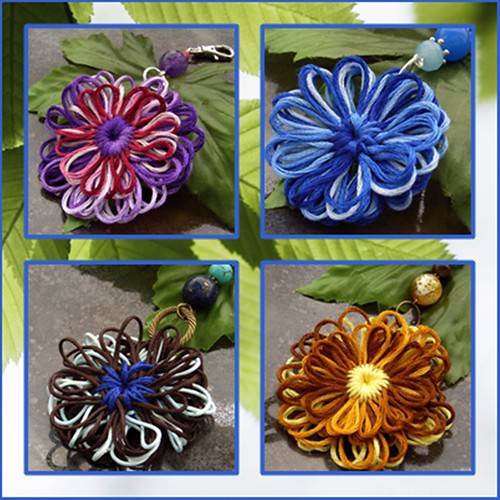It's been a bit of a craft crazy week here - don't know why but some weeks there seems to be a lot of creativity in the air. The weather got better with more sunshine and frost and less cloud and rain and that always has a positive effect on me.
Bag or purse charms have been really popular in my Etsy shop recently - I think it's because it is much easier to get noticed outside of the jewellery category which is always so crowded. Folksy sales are still not happening so my main venues now are Etsy and Storebeez - a fantastic little startup with amazing SEO, getting some of my items on the front page of google searches. Now all I need is for folk to have the confidence to buy from a new and relatively unknown site....

As well as the charms, I was tempted by the lovely Rachel Norris, an amazingly talented jewellery maker, to have a go at twisting wire. The only DIY tool we posses is a power drill, so having located it gathering dust in the bottom of a cupboard, it got its first proper use twisting some bronze wire to make these hoop earrings. They were shown on Jewellery Maker TV this week so now I'm officially 'famous' for using a power drill. Who would have thought that? Lucky you can't do much damage with a power drill.
 And, I've been messing with my flower loom and created some lovely little flowers which I'm making into bag charms, key rings and brooches. Flower looming is relatively easy once you get the hang of the loom, and unlike some other sewing and embroidery projects that I've tried in the past, you can hold the loom up so it doesn't aggrivate my neck problems. At the moment I'm using embroidery cottons for the flowers which give great vibrant colours, but I'm a bit worried about their durability. Chris from Chrissys for Cards has kindly offered to 'road test' one for me, so hers is on it's way to the test site at this moment! Wool and ribbon are the next mediums to try.
And, I've been messing with my flower loom and created some lovely little flowers which I'm making into bag charms, key rings and brooches. Flower looming is relatively easy once you get the hang of the loom, and unlike some other sewing and embroidery projects that I've tried in the past, you can hold the loom up so it doesn't aggrivate my neck problems. At the moment I'm using embroidery cottons for the flowers which give great vibrant colours, but I'm a bit worried about their durability. Chris from Chrissys for Cards has kindly offered to 'road test' one for me, so hers is on it's way to the test site at this moment! Wool and ribbon are the next mediums to try.Not content with just that, I decided to try out needle felting, something I've been interested in for a while. As some of you know, I am a complete disaster area in the field of hand/eye coordination, clumsiness and being generally 'kift' as my husband describes it, so starting a hobby that involves repeatedly stabbing small objects with a barbed needle probably doesn't sound like the best option! Nothing to show so far, but thankfully a really thick glove of hubbie's has protected me from serious wounding. Hopefully my needle felting might progress quickly, and as soon as it looks less the finger painting of a toddler, I be showing it off to you!
Here's the link to find out what others have been making this week.
























